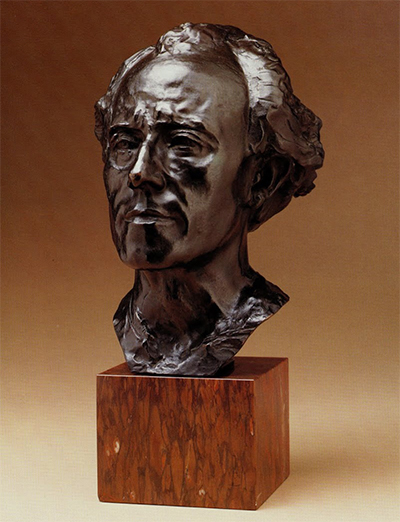This bronze sculpture was completed in 1909 by Auguste Rodin. Gustav Mahler (1860–1911) was a famous composer, though it was rare for Rodin to select someone from this field for his work.
There is plenty of evidence that points to the series of sittings being uncomfortable, with Mahler being an anxious model who preferred to be in his own company, working hard. Despite those difficulties, Rodin was still able to accomplish the fine sculpture that we find in front of us here. It was completed in bronze and captured the model from neckline upwards. It sits on a square wooden stand and the item is now under the ownership of the Metropolitan Museum of Art in the USA. Most of this artist's work remains in Europe, particularly his native France, and so such items as this are rare bonuses for his followers based in North America. There has also been an attempt to purchase items from his studio where ever possible in order to expand that region's coverage of this artist, who remains one of the most famous sculptors in history and regularly receives large scale exhibitions in his name. There has also been a greater focus on his drawings and paintings, as well as photographs from his lifetime, in recent years.
Gustav Mahler was an Austro-Bohemian and one of the leading composers of the late 19th century. This style was believed to have been connected to the Romanticist movement, which involved changes in literature, art and also music. This perhaps connected him to the style of Rodin, as both were essentially forward-thinking artists who were both influential as well as being creatively brave. Alma Mahler, the composer's wife, visited alongside her husband for each of the sittings for this sculpture. She understood the world of art well and had been in the company of other artists before. Despite that, she was still taken aback by some of the methods used by this Parisien sculptor, with her being quoted as saying:
"...His method was unlike that of any other sculptor I have had the opportunity of watching. He first made flat surfaces in the rough lump, and then added little pellets of clay which he rolled between his fingers while he talked. He worked by adding to the lump instead of subtracting from it. As soon as we left he smoothed it all down and next day added more. I scarcely ever saw him with a tool in his hand..."
We believe that the final cast for this piece was made between one and four years after the initial work had been done. It is unlikely to imagine the two keeping a close relationship after this uncomfortable meeting, but we can be sure that the completed sculpture is well respected within Rodin's oeuvre and that it was certainly all worthwhile in the end. It is also interesting to find someone from the field of music becoming involved in his career, though we can't yet explain how this combination actually came about as yet. The artist's museum holds a huge selection of archives from his career and the answers we need are likely to be found within that.




